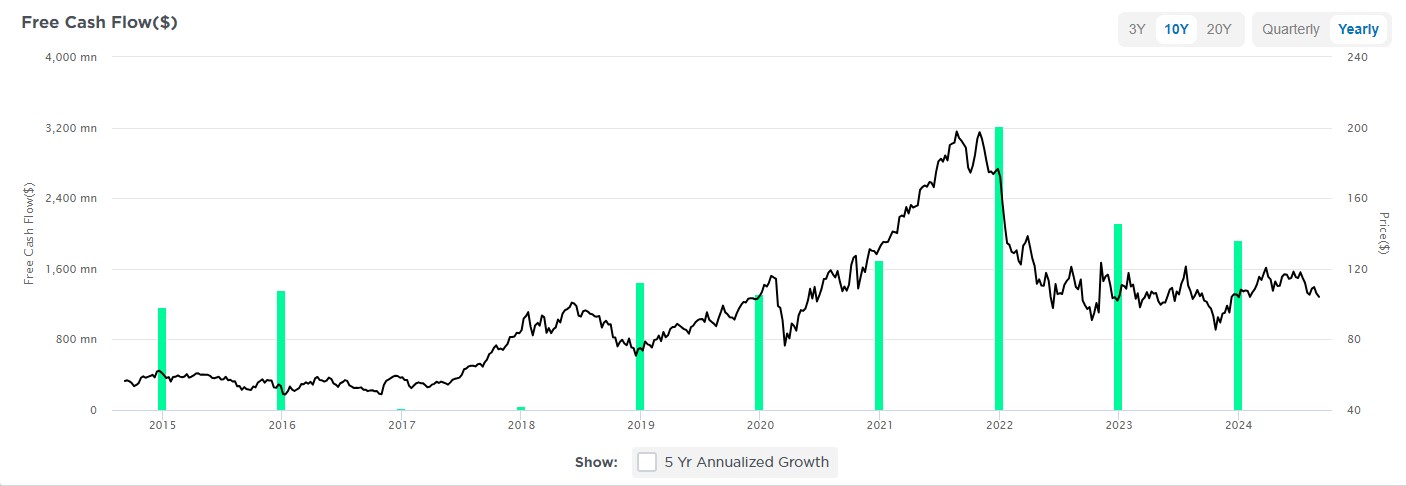T. Rowe Price Group (TROW)
Last week, our dividend yield analysis on Campbell’s Soup (CPB) sparked our interest in the dividend-to-treasury yield dynamics of other low-growth stocks. We reviewed the numbers for several dividend aristocrats and settled on T. Rowe Price Group (TROW) this week. In the context of this analysis, TROW lies on the other end of the spectrum from Campbell’s Soup (CPB).
Fundamentals
While TROW isn’t growing revenue as slowly as CPB, growth has undoubtedly slowed. TROW’s revenue has risen an average of 3.76% annually over the past five years, as shown below. EPS has been declining over the same period, as illustrated by the second chart below. Shrinking margins have led to a 5-year annualized decline in EPS of -10.9%. The company conducts share repurchases, but they haven’t repurchased nearly enough to offset the margin decline.


TROW trades at a dividend yield of 4.75%. Despite a reduction in Free Cash Flow following the decline in margins, TROW still has sufficient coverage of its dividend. The expected annual dividend payments sum to $1.106 billion, while last year’s Free Cash Flow was $1.925 billion.

The chart below shows that TROW is trading at relatively low valuations, given its history. Despite the low valuation, the stock trades at an abysmal PEG ratio of 17.6, reflecting expectations for minimal EPS growth over the next five years.

As we wrote last week, while CPB is technically an equity, its minimal growth rate and consistent dividend make the shares somewhat similar to bonds. As such, we include the following analysis to determine a fair value based on its yield difference versus a risk-free 10-year U.S. Treasury.
CPB’s dividend yield was near its long-term average, while its spread to treasury yields was well below its long-term average. Based on these two criteria, it’s apparent that the stock isn’t necessarily overpriced, but treasury yields are too high.
TROW, in contrast, boasts a dividend yield (4.67%) that’s substantially higher than both its 5-year average (3.41%) and long-term average (2.73%). At the same time, its dividend yield spread to treasuries (0.94%) is substantially above the long-term average (0.18%) and hovering near the 5-year average (0.89%). A dividend yield above the historical average and an above-average yield spread to treasuries indicates that the stock is likely underpriced. The yield spread to treasuries will only widen when yields start falling- unless the stock price rises at a clip fast enough to move the spread closer to normalcy.

Technicals
TROW has given shareholders very little to celebrate this year. The stock is down 1.1% YTD but has followed an ever-so-slight uptrend since 2022. Its MACD is between neutral and oversold but has turned lower over the past week. RSI is similarly between neutral and oversold as the stock tries to find its footing following the recent sharp decline. Investors should look for the stock to find its footing around $103. However, there is plenty of resistance overhead, with the stock trading below each of the 20-, 50-, and 200-day moving averages. Investors will likely be presented with better opportunities when the Fed cuts rates, making the dividend spread to Treasury yields even more attractive.

Disclosure
This report is not a recommendation to buy or sell the named securities. We intend to elicit ideas about stocks meeting specific criteria and investment themes. Please read our disclosures carefully and do your own research before investing.




